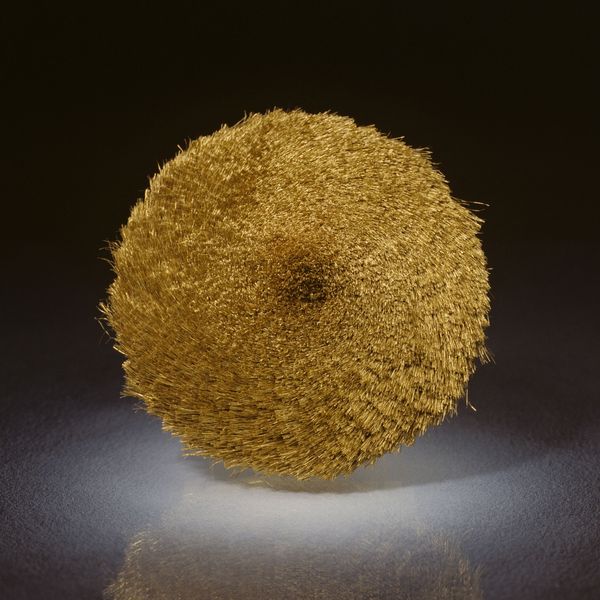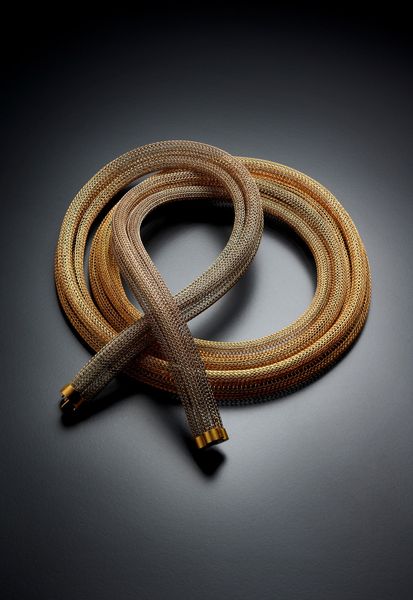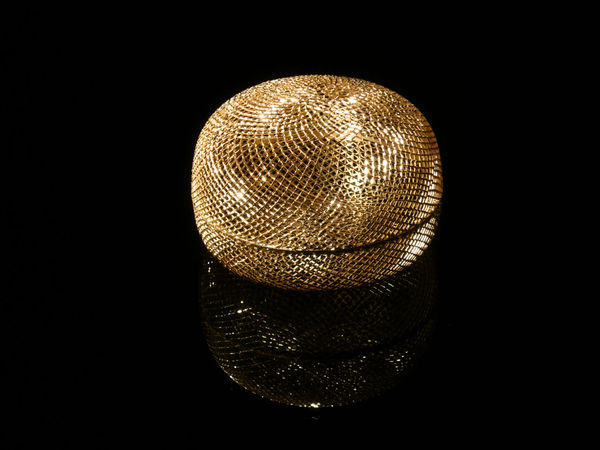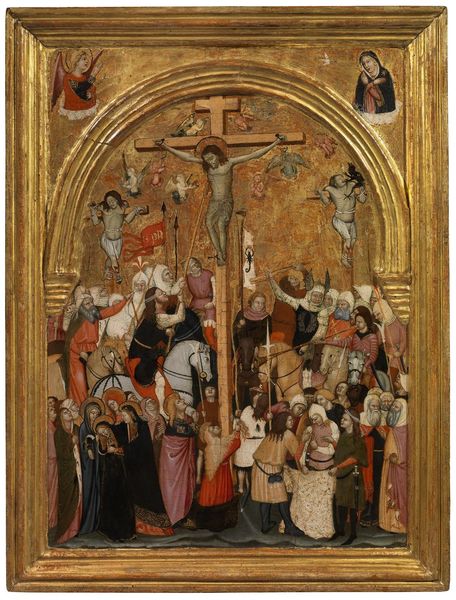Gold: Status and Glory. Masterpieces from the Middle Ages and Today
Giovanni Corvaja (b. 1971), The Golden Fleece Brooch, 2007, 18 ct gold. Depth: 2.3 cm; diameter: 6 cm. Adrian Sassoon, London.
The timeless allure of gold will be celebrated in an exceptional exhibition entitled Gold: Status and Glory and is the result of a collaboration between two dealers, Adrian Sassoon and Moretti Fine Art. It will be staged at Moretti Fine Art, 2a-6 Ryder Street, St. James’s, London SW1, from 2 to 31 May 2013. Fabrizio Moretti explained: “As a gallery specialising in Italian Old Masters, we are constantly confronted with the magnificence of gold. This exhibition is an opportunity to examine this highly prized material in the contexts of decoration, devotion and drama.” Gold: Status and Glory will present fifteen exquisite objects by the contemporary Italian goldsmith Giovanni Corvaja in the context of 14th and 15th century Italian gold-ground devotional paintings.
Giovanni Corvaja (b. 1971), Bracelet, 2010, 18 ct gold cage, 950 platinum wire and coloured enamel. Depth: 3 cm; diameter: 12 cm. Adrian Sassoon, London.
Giovanni Corvaja has been fascinated and inspired by metals, especially gold, since early childhood. His jewellery is represented in some of the most famous public collections in the world not only as jewellery for adornment but also, as the respected British jewellery specialist and author Geoffrey Munn OBE says in his catalogue essay for the exhibition, “as examples of miraculous contemporary craftsmanship and art”. Munn continues “Ductile, malleable and incorruptible gold holds a deep fascination for Corvaja. However, the miraculous qualities of the metal, especially its unique beauty, can only be revealed by the experience and skill of the goldsmith. Although Giovanni Corvaja follows a very ancient tradition in his workshop in Todi in Italy, he has developed skills and techniques that have broken all previous bounds. Central to these is the ability to draw the precious yellow metal into threads hardly thicker than a spider’s silk”.
Giovanni Corvaja (b. 1971), Necklace, 2011, 18 ct gold, 19 alloys shading from white to yellow to white again. Length: 130 cm. Adrian Sassoon, London.
In ancient times gold was collected by staking riverbeds with sheepskins rich in lanolin. The water drove tiny grains of gold across the surface of the wool where they were entrapped. The skin was then dried and burned leaving only pure gold behind. This is probably the origin of the legend of the Golden Fleece. Its magic has inspired Giovanni Corvaja’s recent work in which he has woven gossamer strands of gold into the semblance of fur and wool and gathered it in frames and honeycombs to be worn as bracelets, brooches and pendants. Light and air pass freely through these sculptural jewels and sometimes, in the tradition of the Etruscan goldsmiths, tiny beads of coloured enamel heighten their unique effect, raising jewellery, once again, to the highest level of art.
Giovanni Corvaja (b. 1971), The Golden Fleece Headpiece, 2008-9, 18 ct and 22 ct gold. Height: 27 cm; diameter 35 cm. Adrian Sassoon, London.
After more than a decade of ceaseless application and research, this truly remarkable artist discovered a particular alloy of gold that was both a beautiful colour and unusually ductile allowing it to be drawn to a fineness of less than ten microns. For over 1,500 hours Corvaja wove this thread and produced an extraordinary cloth made from 110 kilometres of almost transparent gold wire, a masterpiece of tactile experience, being both cool and silky smooth. It is possible to subtly change the hue of gold from buttercup yellow to fugitive shades of pink and green and even moonshine white by making an alloy with other metals. Giovanni enjoys experimenting and, for added magic, has created a warp made of threads, each composed of 291 wire fibres in a pale yellow 18 ct gold, while the weft is of a yellow-orange 22 ct gold alloy and has braided threads also comprising 291 wires. The result is a cloth that is almost pure gold in colour with subtle shimmering variations.
Giovanni Corvaja (b. 1971), Carved Box, 2012, 18 ct yellow gold. Height: 5.6 cm; diameter 9 cm. Adrian Sassoon, London.
The fifteen exquisite pieces by Corvaja to be shown in this exhibition are each made from 18ct gold and include a Golden Fleece brooch, an elaborate gold cage bracelet with 950 platinum wires and coloured enamel, a sinuous necklace made with 19 alloys shading the gold from white to yellow and back to white again, and a Golden Fleece headpiece made of 18 and 22 ct gold cloth, comprising over five million single strands making a total of 200 kilometres of wire.
Giovanni Corvaja was born in 1971 in Padua and was educated in that city of goldsmiths where he was taught by the celebrated master goldsmith, Francesco Pavan. He began to work with gold in 1984 when he was just 13 and immediately recognised it as his métier. In 1988 he was awarded the Diploma di Maestro d’Arte and in 1990 the Maturità d’Arte Applicata. In 1990 he enrolled in the Royal College of Art in London to continue studying art jewellery, graduating with an MA in 1992 when he returned to Padua. In 2001 he moved to Todi, a historical Etruscan town in central Italy, where he has restored a 15th century building, now his spacious workshop. His career has also been distinguished with four solo exhibitions and numerous group shows throughout the world.
Neri di Bicci (1418-1492), St Lawrence in Glory with four angels, 1470-1475. Panel, 38 x 24.5 cm. Moretti Fine Art.
The use of gold in Trecento and Quattrocento gold-ground pictures gave the illusion that the panels were made of solid gold, creating ethereal images with an illusion of heaven. The metal was meticulously handled to prevent cracks or faults when it was placed onto the bole (a prepared clay surface). Among the eight fine examples of such works in this show will be St Lawrence in Glory with four angels by Neri di Bicci, (Florence, 1418-1492), one of the masterpieces in the huge corpus of works attributed to the artist. The fine painted decoration of the rear of the panel, with the monogram of Christ at the centre, is almost certainly contemporary with the image on its front and the little painting, outstanding for its exquisite workmanship and the richness of its decorative aspects, is one of the finest achievements of Neri di Bicci’s mid career in the early 1470s.
Veronese Painter (c. 1380-1390), Crucifixion and Annunciation. Panel, 67 x 49.8 cm. Moretti Fine Art.
Crucifixion and Annunciation, dating from around 1380-90 by an unknown artist from Verona, is a rare example of a Veronese painting on panel for this period as frescoes were more usual. The composition is constructed on three levels: in the foreground the mourners stand on the left while to the right soldiers are disputing the robe of Christ; behind them in the middle ground are surging ranks of horsemen, an idea deriving from Giotto; and in the upper part Christ is depicted between the thieves and the lament of the angels. The scene is remarkably animated with the many heads at the bottom, the variety of gestures and the frenetic interaction of the figures. The Annunciation, painted with the Angel Gabriel in the upper left corner and the Holy Spirit in the form of a dove flying towards the Virgin in the right, together with other stylistic elements, all point to the hand of a Veronese painter.
Maestro Francesco (active c. 1380-c. 1400), The Coronation of the Virgin, with Saints. Panel, shaped top: 95.4 x 56.2 cm including an addition of 7.9 cm to the top. Moretti Fine Art.
The Coronation of the Virgin, with Saints Nicholas of Bari, Anthony Abbot, John the Baptist, Francis of Assisi, Phillip and Zanobi, a beautiful work by Maestro Francesco (active Florence c. 1380-c. 1400), was formerly in the collection of H.R.H. Princess Louise, Duchess of Argyll, one of Queen Victoria’s daughters. She gave it to Christ Church, Victoria Road, London, in 1932 and it later belonged to the Chrysler Museum of Art, USA.
From the secular to the sacred, Gold: Status and Glory will offer visitors a remarkable experience which will show the timeless appeal and symbolism of gold as it was perceived in imagery of the Middle Ages juxtaposed with Giovanni Corvaja’s work, representing the finest craftsmanship of the 21st century.

/https%3A%2F%2Fprofilepics.canalblog.com%2Fprofilepics%2F1%2F0%2F100183.jpg)
/https%3A%2F%2Fstorage.canalblog.com%2F03%2F02%2F119589%2F96711876_o.jpg)
/https%3A%2F%2Fstorage.canalblog.com%2F11%2F31%2F119589%2F94773502_o.jpg)
/https%3A%2F%2Fstorage.canalblog.com%2F20%2F83%2F119589%2F94772815_o.jpg)
/https%3A%2F%2Fstorage.canalblog.com%2F26%2F72%2F119589%2F75604929_o.jpg)
/https%3A%2F%2Fstorage.canalblog.com%2F59%2F60%2F119589%2F26458628_o.jpg)










/image%2F1371349%2F20240508%2Fob_d997ec_d21e3e110569bdfa219529297300e28a-1402x.png)
/image%2F1371349%2F20240508%2Fob_4c468b_telechargement-4.jpg)
/image%2F1371349%2F20240508%2Fob_7c1cc0_telechargement.jpg)
/image%2F1371349%2F20240507%2Fob_6e4c73_telechargement-17.jpg)